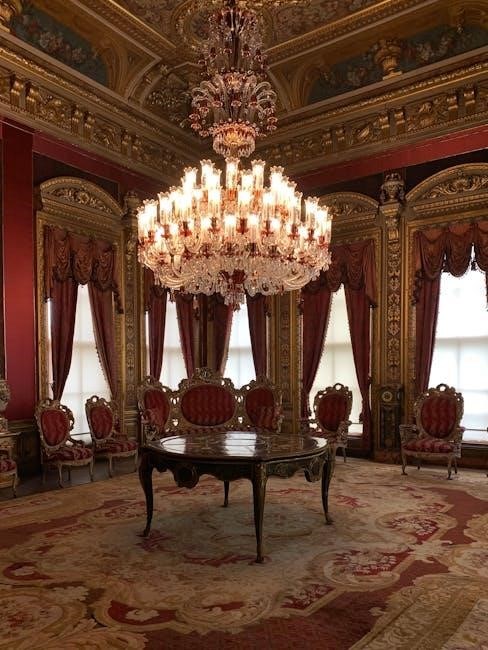
Giovanni’s Room is a landmark novel by James Baldwin, published in 1956, exploring themes of identity, love, and societal pressures through David’s tumultuous affair in 1950s Paris.
1.1 Overview of the Novel
Giovanni’s Room, published in 1956, is set in 1950s Paris and follows David, an American expatriate, as he navigates a passionate yet tumultuous relationship with Giovanni, an Italian bartender. The novel delves into themes of identity, sexual orientation, and societal pressures, exploring David’s internal conflict and the emotional costs of betrayal. It remains a powerful exploration of love, shame, and self-acceptance, resonating deeply with contemporary readers.
1.2 Historical Context and Publication
Giovanni’s Room was published in 1956, a time of societal conservatism, and faced initial rejection due to its explicit portrayal of same-sex relationships. James Baldwin, a Black gay man, broke barriers with this novel, offering a frank exploration of love and identity. Despite the challenges, the book became a groundbreaking work, reflecting the struggles of the LGBTQ+ community in 1950s Europe and beyond, solidifying Baldwin’s legacy as a fearless writer.

Plot Summary and Main Characters
Giovanni’s Room follows David, an American in 1950s Paris, grappling with his identity and desire. His tumultuous relationship with Giovanni, an Italian bartender, unfolds amid societal pressures and personal turmoil, exploring themes of love, shame, and betrayal in a repressive era.
2.1 David and Giovanni: Central Characters
Daniel and Giovanni are the emotional core of the novel. David, an American expatriate, grapples with his sexual identity and societal expectations, while Giovanni, an Italian bartender, embodies raw passion and vulnerability. Their relationship is marked by intense passion and mutual destruction, reflecting the internalized shame and fear of acceptance prevalent during the 1950s. Both characters represent conflicting desires and the struggle for self-acceptance in a repressive society.
2.2 The Setting: Paris in the 1950s
The novel is set in 1950s Paris, a city of artistic freedom and moral ambiguity. This backdrop of bohemian culture and expatriate life provides the stage for David and Giovanni’s relationship. The city’s vibrant nightlife and underground gay bars serve as both a refuge and a trap, reflecting the tension between liberation and repression. Paris becomes a symbol of escape and self-discovery, yet also a place of isolation and internal conflict for the characters.

Themes and Symbolism
Giovanni’s Room delves into themes of identity, sexual orientation, and societal pressure, using Paris as a backdrop for emotional conflict and self-discovery, rich in symbolic depth.
3.1 Identity and Sexual Orientation
In Giovanni’s Room, James Baldwin masterfully portrays the struggle for self-acceptance through David’s internal conflict with his sexual orientation. Set in 1950s Paris, the novel explores the societal pressures that force David to conceal his true desires, leading to a tangled web of guilt and betrayal. Baldwin’s vivid depiction of David’s relationship with Giovanni exposes the emotional toll of denying one’s identity, resonating deeply with themes of shame and liberation in a repressive era.
3.2 Societal Pressures and Internalized Shame
Giovanni’s Room delves into the profound impact of societal expectations on individual identity. David’s internalized shame stems from the oppressive norms of 1950s Paris, where homosexuality was stigmatized. Baldwin illustrates how these pressures lead to self-loathing and destructive behavior, as David struggles to reconcile his desires with the demands of a heteronormative world. This internal conflict mirrors the broader societal repression of the time, highlighting the enduring consequences of forced conformity.

Historical and Social Context
Giovanni’s Room is set in 1950s Paris, reflecting the oppressive societal norms of the time. The novel explores the intersection of racial and sexual identity in a repressive era, highlighting the struggles faced by marginalized communities.
4.1 The 1950s LGBTQ+ Experience
Giovanni’s Room captures the clandestine nature of LGBTQ+ life in 1950s Paris, where same-sex relationships were shrouded in secrecy and societal condemnation. The novel reflects the era’s oppressive norms, where individuals like David and Giovanni grappled with internalized shame and the fear of exposure. Baldwin’s portrayal of their struggles highlights the emotional toll of living in a society that denied their existence and forced them into hiding.
4.2 Racial and Cultural Dynamics
Giovanni’s Room delves into the intersection of race and culture, as David, an American expatriate, navigates his identity in Paris. Baldwin subtly explores the racial undertones of David’s relationships, particularly with Giovanni, an Italian man. The novel highlights the tensions between American and European cultural norms, while also reflecting Baldwin’s own experiences as a Black, gay man in a predominantly white, heteronormative society.

James Baldwin’s Background and Influence
James Baldwin, born in 1924, was a Black, gay writer who fled America to escape racism and homophobia. His experiences shaped Giovanni’s Room, reflecting his struggle for identity and societal acceptance, leaving a profound legacy in LGBTQ+ and racial literature.
5.1 Baldwin’s Personal Struggles and Writing Style
James Baldwin faced profound personal struggles, including racism, homophobia, and identity crises, which deeply influenced his writing. He fled America to Europe, seeking refuge from societal oppression. His lyrical, introspective style in Giovanni’s Room reflects his emotional depth and raw honesty, blending personal pain with universal themes of love and alienation, creating a powerful narrative voice that resonates with readers.
5.2 The Novel’s Place in Baldwin’s Oeuvre
Giovanni’s Room stands as a pivotal work in James Baldwin’s oeuvre, marking a bold exploration of homosexuality and identity. Published after his debut Go Tell It on the Mountain, it showcased his willingness to tackle controversial themes. The novel’s success solidified Baldwin’s reputation as a fearless writer, blending racial and sexual issues with lyrical prose, setting the stage for later works like Another Country and cementing his legacy as a literary icon.

Literary Style and Techniques
Baldwin’s lyrical prose and non-linear narrative structure in Giovanni’s Room create a deeply immersive experience. His vivid imagery and sensory details evoke 1950s Paris, while his exploration of internal conflicts and emotional complexity adds profound depth to the story.
6.1 Narrative Structure and Language
Baldwin’s narrative structure in Giovanni’s Room employs a non-linear, introspective style, blending past and present to enhance emotional depth; His lyrical prose, rich with vivid imagery, captures the essence of 1950s Paris. The language is both poetic and raw, reflecting the internal turmoil of the characters. Baldwin’s mastery of dialogue and description immerses readers in David’s world, exploring themes of identity and desire with unflinching honesty and literary brilliance.
6.2 Use of Symbolism and Metaphor
Baldwin masterfully employs symbolism and metaphor in Giovanni’s Room, with the titular room serving as a poignant symbol of isolation and confinement. The bar where David and Giovanni meet represents a liminal space of transition and forbidden desire. Light and darkness are recurring metaphors, symbolizing truth and secrecy, while reflections and mirrors explore themes of identity and self-perception. These elements enrich the narrative, adding depth to the emotional and psychological struggles of the characters.

Reception and Legacy
Giovanni’s Room faced initial controversy but is now a classic, praised for its raw portrayal of same-sex love; Its PDF version remains widely read, ensuring its enduring impact.
7.1 Initial Reception and Controversy
Giovanni’s Room initially faced significant controversy due to its explicit portrayal of same-sex relationships. Published in 1956, the novel was rejected by Baldwin’s publishers, who deemed its content too provocative. The story’s raw exploration of gay love and identity shocked audiences, leading to both criticism and acclaim. Despite the backlash, the novel’s unflinching honesty solidified Baldwin’s reputation as a fearless writer, paving the way for future LGBTQ+ literature.
7.2 Modern Interpretation and Significance
Giovanni’s Room is now celebrated as a pioneering work in LGBTQ+ literature, offering profound insights into identity and societal oppression. Its exploration of internalized shame and self-denial resonates deeply with modern readers. Baldwin’s nuanced portrayal of queer experiences continues to inspire, making the novel a timeless classic that challenges norms and fosters understanding of human complexity and the universal quest for acceptance.
Character Analysis
David and Giovanni embody the novel’s exploration of identity and internal conflict, with David’s struggle with his sexuality and Giovanni’s tragic fate highlighting the cost of societal repression.
8.1 David’s Internal Conflict
David’s internal conflict revolves around his identity and sexual orientation, as he grapples with societal expectations and personal desires. His engagement to Hella contrasts with his passionate relationship with Giovanni, highlighting his struggle to reconcile his true self with societal norms. This duality leads to self-loathing and a fragmented identity, underscoring the emotional cost of internalized shame and repression in Giovanni’s Room.
8.2 Giovanni’s Role and Impact
Giovanni embodies authenticity and passion, challenging David’s internalized shame and societal conditioning. His genuine affection forces David to confront his repressed desires, yet their relationship ends in tragedy due to David’s inability to accept himself. Giovanni’s presence highlights the emotional toll of societal norms, making him a pivotal figure in David’s journey toward self-discovery and the novel’s exploration of identity and oppression. His impact lingers, underscoring the cost of forbidden love.
Giovanni’s Room remains a poignant exploration of identity, love, and societal norms, offering profound insights into the human condition. Its emotional depth and relevance endure, leaving a lasting impact on readers.
9.1 The Novel’s Enduring Relevance
Giovanni’s Room continues to resonate as a powerful exploration of identity, love, and societal norms. Its unflinching portrayal of internalized shame and the struggle for self-acceptance remains deeply relevant today, offering universal insights into the human condition.
Baldwin’s masterful narrative captures the emotional cost of conformity, making the novel a timeless reflection on the enduring complexities of human relationships and societal expectations.
9.2 Final Thoughts on “Giovanni’s Room”
Giovanni’s Room remains a profound and deeply moving novel, offering insights into identity, love, and societal norms. Baldwin’s fearless exploration of human complexity ensures its lasting impact, resonating with readers seeking understanding of themselves and the world around them.